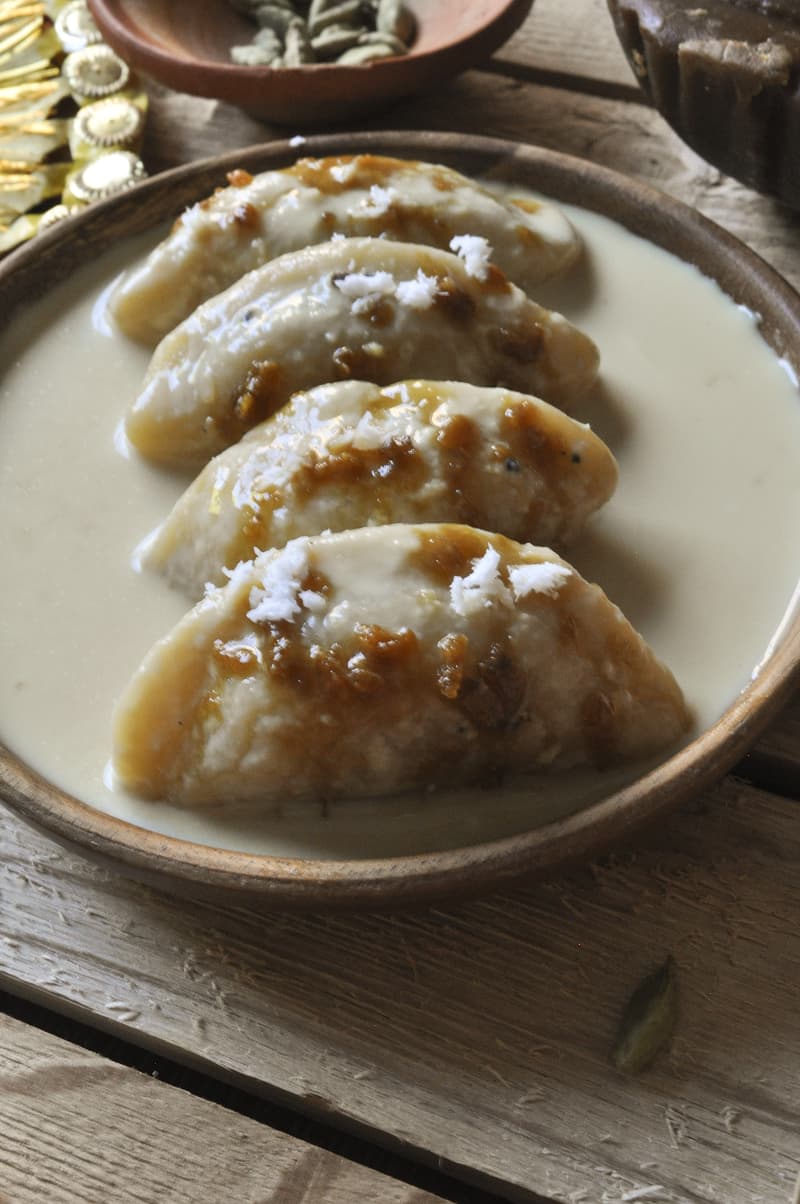
Dudh Puli Recipe or Pooli Pithe is a Poush/Makar Sankranti classic in my culture. According to the Hindu calendar, Sankranti is celebrated to mark the end of the month-long winter solstice and the start of longer days or so Wikipedia says. I remember when my grandma was alive; she would do a small puja or religious ceremony in observance of the occasion. Mom was never really very religious, so except for the food part of it, I do not remember much. The stuff I remember though is that baba, my dad, made a big deal of things like “notun gur” (new jaggery literally), “purono gur” (old jaggery), “notun chal” (new rice), purono chal” (old rice) etc.
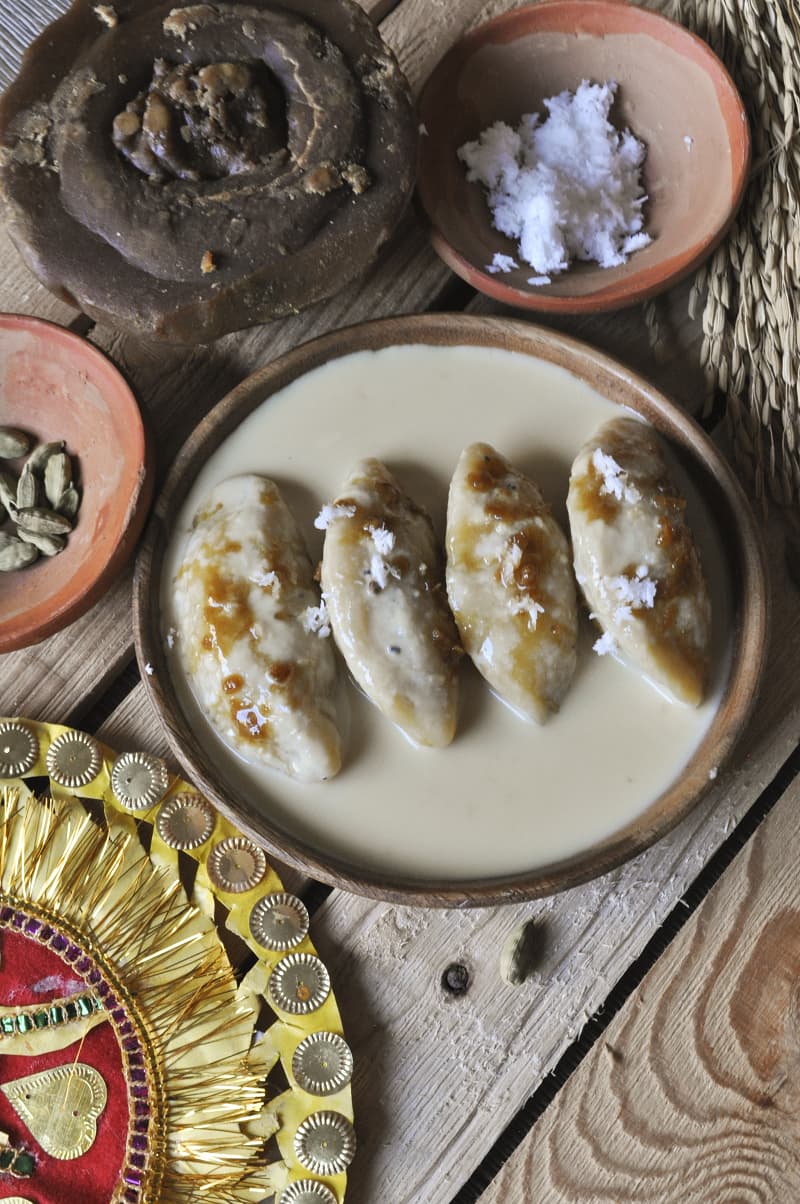
Dudh Puli Recipe – Bengali Puli Pitha
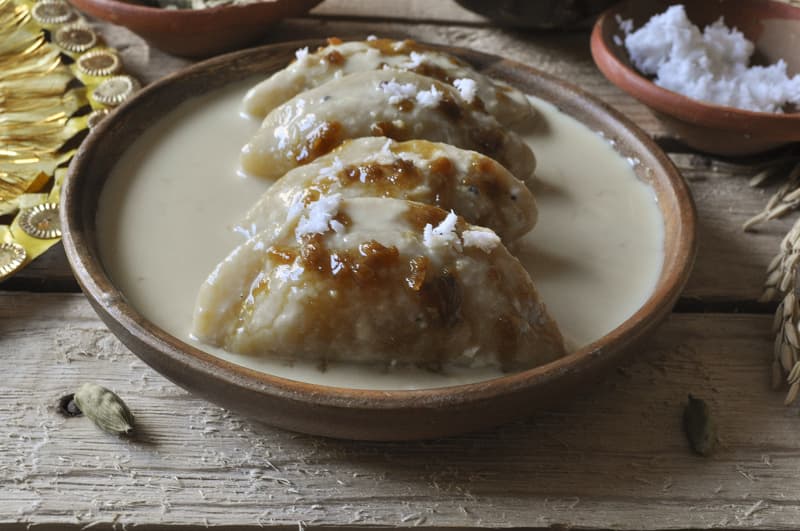
This festival is also a celebration of a good harvest and it is considered that this is the season when the harvest of the previous year’s crop is complete. So all the festive treats this time of the year across any part of India inadvertently involved indigenously produced healthy ingredients. Rice, coconut, and jaggery (in our case date palm jaggery) would be the three main ingredients of the Sankranti treats.
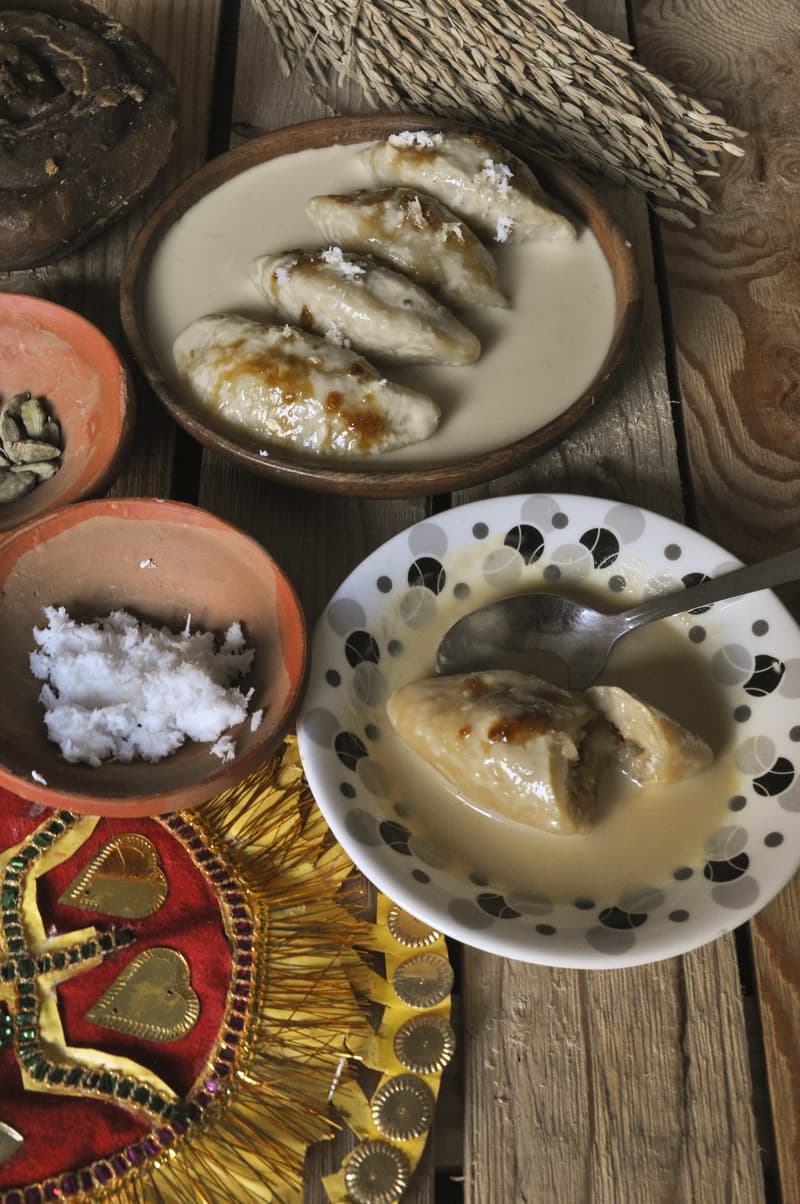
The sweets prepared for Sankranti are generally referred to as “pithe” or “pitha”. And there are many kinds but the basic ingredients are same. I just posted the Chooshi Pithe [2] recipe last week. And this week I have for you Dudh Puli/Pooli or Puli pithe.
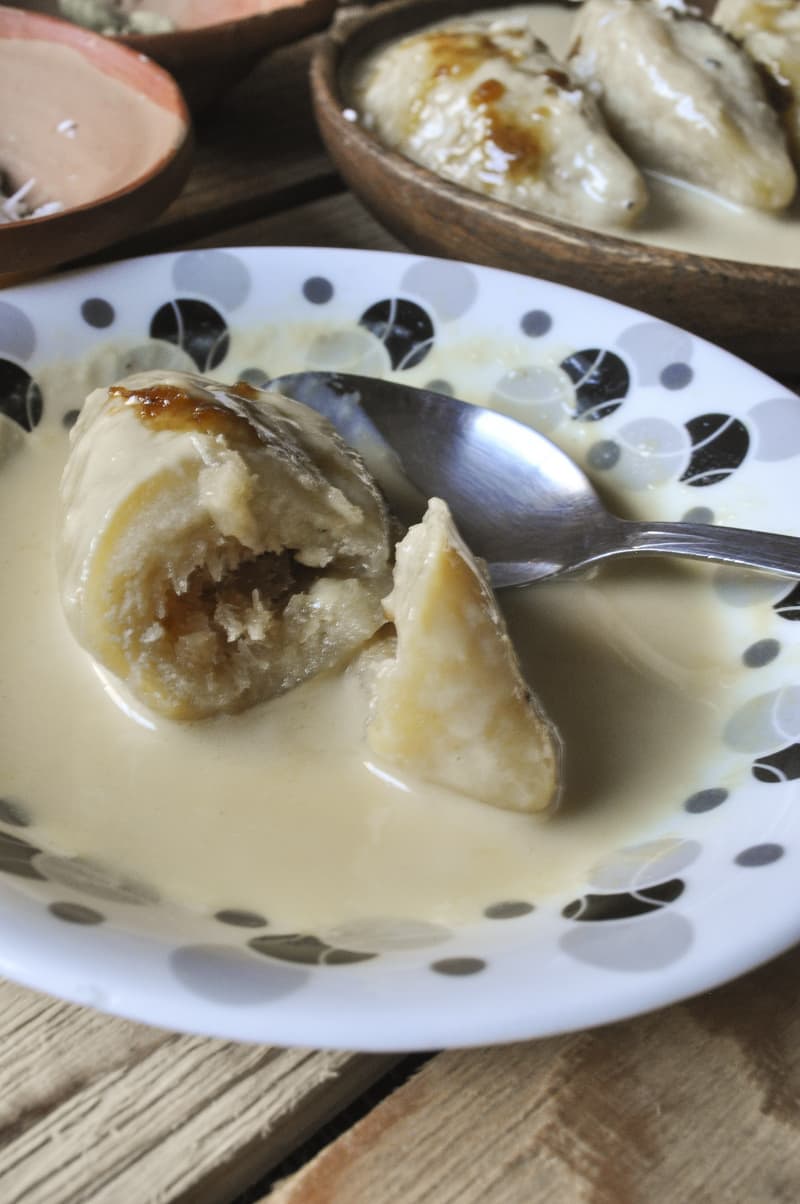
Again a labor-intensive and traditional delight which we indulged only during this time of the year but my family has this weird tradition of preparing this treat also during any baby shower in the family. So when G was due, while mom in law took care of the rest of the menu, my mom and sister made puli pithe till late in the night, the night before the event in March. Made from ground rice, the finest patali gur (date palm jaggery) and coconut, this is something I am not very good at. So this time when Maa and Samrat’s parents were visiting, I asked them to make this. In fact, Sam’s dad is really good at it. So he prepared the filling beforehand and later on Maa and mom in law helped him to make the shells and then cook them. I clicked the pics and noted down the recipe and then later enjoyed the treat. Moms are the best 🙂
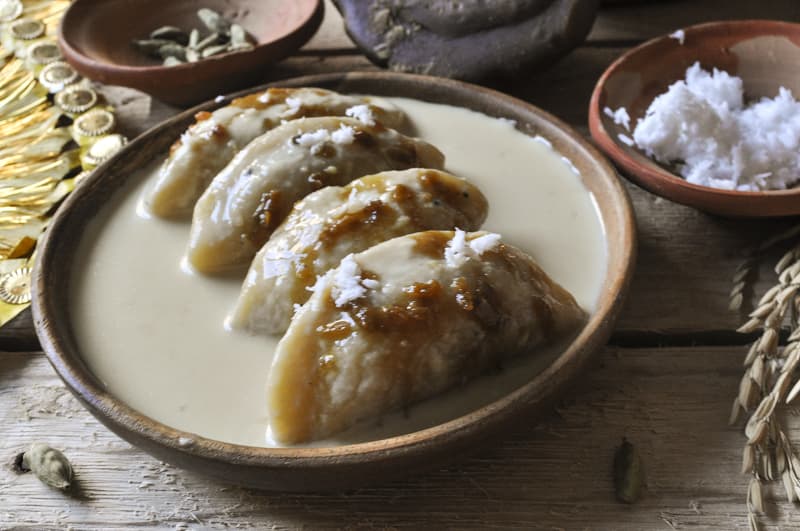
Along with Dudh Puli Recipe, You may also like the recipes below:
Print [6]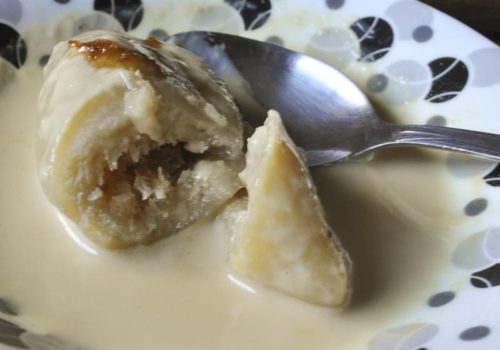
Dudh Puli / Dudh Pooli – Puli Pithe
- Prep Time: 15
- Cook Time: 90
- Total Time: 105
- Yield: 20
Description
A traditional and nostalgic Sankranti treat that uses the very seasonal Nolen Gur ( date palm jaggery), fragrant rice grains and the finest coconut.
Ingredients
For the Coconut Filling
- Ghee – 2 tsp
- Grated Coconut – 11/2 cup
- Date Palm jaggery – 3/4 cup(grated or cut into very small pieces)
- Sugar – ¼ cup
- Khoya Kheer – ½ cup (reduced Milk solids)
- Cardamom Powder – 1 tsp
For the pithe
- Rice Flour – 1 1/4 cup
- Boiling water – 1 cup
- Salt – ½ tsp
For the Kheer
- Whole Milk – 1 1/2 liters
- Sugar – 1/2 cup
- Date Palm Jaggery (NolenGur) – ½ cup,grated
- Cardamom Powder – 1 tsp ( or crushed cardamom pods)
Instructions
For the Coconut Filling
- Heat a heavy bottomed pan, pour the ghee.
- Add the grated coconut and fry for 3-4 minutes.
- Add the sugar and mix it in. The sugar will caramelize and change the color of the mixture. This takes about 3-4 mins.
- Add the khoya and mix it in along with the jaggery. Keep stirring on a low flame, till the jaggery is melted and well incorporated. The consistency should be such that a ball of the coconut mixture when fisted should hold its shape.
- Once done remove from stove, add the cardamom powder and mix it in.
- Let it come to a room temperature.
For the Pithe
- Boil the water in a pan along with the salt. Remove from stove and very carefully start pouring in the rice flour a little at a time and mix it in. The entire thing should come together in dough like the classic bread dough.
- If you feel you have not got the right texture and it’s soft, add a tbsp. of rice flour. If it is hard and dry, add a tbsp. of hot water and work on it.
- Now cover the bowl with a wet paper towel and let it rest for 10 mins. Grease your palms a little and knead the dough. If it’s still sticky add a little dry rice flour.
- After that make small balls out of the dough, kind of like a little small than the size of a golf ball.
- Flatten the ball between the palm of your hands and then using your fingers stretch the sides in such a way that the sides become thinner and the diameter of the little circle increases, however, the middle is relatively thicker. The idea is to make something like an empanada.
- Add a tbsp. of the coconut mixture in the middle and seal in the sides. If the dough has the right texture, the pithe will not break.
- Now complete all the pithes with the remaining rice flour dough and coconut filling.
For the Kheer
- Bring the milk to a boil and turn the stove to a medium flame and let the milk bubble up and reduce. This step takes about 20-25 mins and the milk should become half its original consistency.
- Add the sugar and mix it in and now slowly start adding the pithes that were made earlier. The pithes should be cooked in the boiling milk for a good 7-8 mins. Once cooked they will start floating on the surface and it is time to fish them out and removed and kept in a separate bowl . The pithes should not be overcooked.
- After all the pithes are cooked, turn off the stove and add the jaggery, let it melt and mix in with the milk.
- Now add back all the pithes along with the cardamom powder. Let it come to room temperature. This takes 30 mins.
- Once done, the pithes are ready to be served and enjoyed.
Notes
- Never put the jaggery in the boiling milk as it may cause the milk to split. Parboiled rice flour is traditionally used as it makes the softest pithes but I did not get parboiled rice flour here, so made it with regular rice flour.
Nutrition
- Serving Size: 8
- Calories: 0
- Sugar: 0
- Sodium: 0
- Fat: 0
- Saturated Fat: 0
- Unsaturated Fat: 0
- Trans Fat: 0
- Carbohydrates: 0
- Protein: 0
- Cholesterol: 0
Keywords: Puli Pithe Recipe, Dudh Puli Recipe
Find it online: https://www.myfridayfoodswings.com/dudh-pulipooli/ [8]